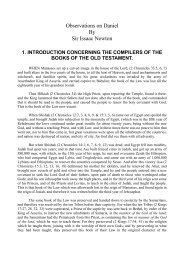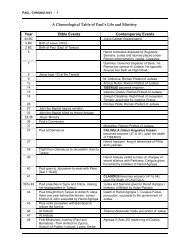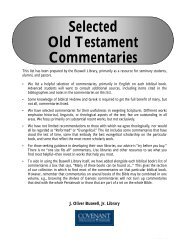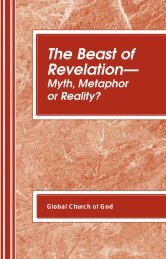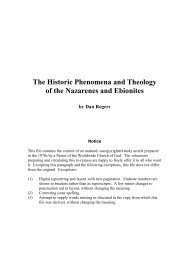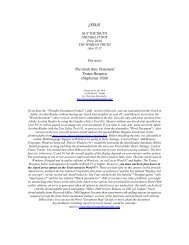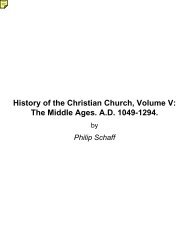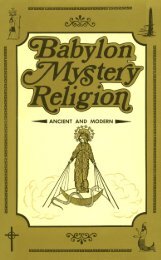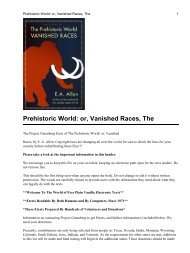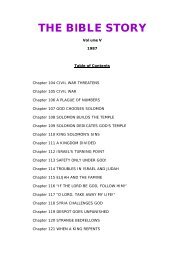Plain Truth 1957 (Vol XXII No 07) - Herbert W. Armstrong Library ...
Plain Truth 1957 (Vol XXII No 07) - Herbert W. Armstrong Library ...
Plain Truth 1957 (Vol XXII No 07) - Herbert W. Armstrong Library ...
You also want an ePaper? Increase the reach of your titles
YUMPU automatically turns print PDFs into web optimized ePapers that Google loves.
July, <strong>1957</strong> The PLAIN TRUTH Page 5<br />
lived southeast of Palcstinc near Petm.<br />
Arab Bedouins live there now. Then<br />
where have Esau’s children gone?<br />
From the days of Nebuchadnezzar,<br />
who carried them captive, they disap-<br />
pear for 1000 years from history. Then<br />
suddenly we find Amalek the name of a<br />
city in TurRestan in Central Asia (from<br />
Paul Herrmann’s Sieben uorbei und Acht<br />
Verweht, p. 45 1 ) . The Egyptians used to<br />
call the Amalekites Amu. In Turkestan is<br />
the River Amu today! In Bible times the<br />
Edomites inhabited Mt. Seir (Gen. 32:<br />
4). In Turkestan is the Syr Darya-the<br />
River of Syr or Seir.<br />
The leading Turkish tribe is the Otto-<br />
man. The prophecies referring to Edom<br />
or Esau mention Teman as the leading<br />
tribe in these latter days (Obadiah 9)<br />
The conclusion is inescapable. The Otto-<br />
man Turks are the sons of Teman. Mere-<br />
ly the vowels in spelling have been<br />
changed over these past millenniums.<br />
From Central Asia the Turks or Edo-<br />
mites moved into Asia Minor. That is<br />
where Esau’s children live today! Tur-<br />
key controls the “crossway” of the na-<br />
tions-the Dardanelles (Obadiah 14).<br />
How clear, ESAU OR EDOM IS TURKEY<br />
today!<br />
There is not room in this article to ex-<br />
plain where Jacob’s children journeyed.<br />
If you want a summary, write for Mr.<br />
<strong>Armstrong</strong>’s FREE booklet “The United<br />
States and the British Commonwealth in<br />
Prophecy.” A future installment in this<br />
series will explain where all ten tribes<br />
of Israel are today!<br />
Who Are the Chaldeans Today?<br />
Abraham lived among the Chaldeans.<br />
One whole book of the Bible-Habak-<br />
kuk-is entirely devoted to a prophecy<br />
concerning the Chaldeans in these latter<br />
days! But where are the Chaldeans to-<br />
day? Certainly they are not at ancient<br />
Babylon. <strong>No</strong> one lives there!<br />
<strong>No</strong>tice first where the Chaldeans were.<br />
Abraham came from “Ur of the Chal-<br />
dees.” Ancient Ur was in Mesopotamia.<br />
Ur is a shortened name for Urfa. There<br />
were once two cities by that name. Ste-<br />
phen, in his inspired sermon, makes plain<br />
that it was the northern Ur in Mesopo-<br />
tamia from which Abram came (Acts 7:<br />
2-3). That is where the Chaldeans first<br />
dwelt-over 400 miles northwest of<br />
ancient Babylon.<br />
Who are these Chaldeans so frequent-<br />
ly mentioned in Bible prophecy?<br />
Here is the p!ain, simple explanation<br />
recognized by most Hebrew scholars.<br />
The word “Chaldean” comes from the<br />
Greek. The original Hebrew word is<br />
Chasdz’m, meaning “the peoples of<br />
Chesed.” <strong>No</strong>tice that Chesed was a com-<br />
mon name in the family of Abraham<br />
(Gen. 22:22).<br />
Next, consider the original Hebrew<br />
word translated in our Bibles as “Arph-<br />
axad.” Most biblical encyclopaedias will<br />
clearly show that the Hebrew form is<br />
Arfa-chesed-MEANING ARFA OR URFA<br />
THE CHALDEAN! The Chaldeans come<br />
from Arphaxad. They are his children.<br />
Abraham was a branch of this stock! The<br />
city of Ur was named after Arfa or Urfa,<br />
the Chaldean. Chaldean probably means<br />
“capturer,” just as Jacob means “supplanter.”<br />
The reason that some Chaldeans were<br />
later associated with Babylon in Daniel’s<br />
time is that a small part of them was<br />
later settled by the Assyrians near Babylon.<br />
The original inspired Hebrew of<br />
Isaiah 23: 13 explains this: “Behold, the<br />
land of the Chaldeans-this is the people<br />
that was not, when Asshur founded<br />
it for shipmen.” How clear. The Chaldeans<br />
were divided, not an orga%jzed nation.<br />
A part of them was transplanted to<br />
Babylon. At Babylon they became the<br />
raling class. But the remainder settled<br />
farther north around Lake Van, about<br />
halfway between the Caspian Sea and<br />
the Mediterranean. Here they were called<br />
Chaldians, or, more often, the people of<br />
VAN. Sometimes they were referred to as<br />
HURRI or Hurrians, after Haran (Gen.<br />
1 1 : 29; 22 : 20-24 ) . Sometimes they bore<br />
the name GUTI, probably meaning “people<br />
of God.” Remember these names!<br />
They are a KEY-to what happened to<br />
them.<br />
<strong>No</strong>w what befell these people? History<br />
records that they were driven northward<br />
out of the Near East by the Assyrians<br />
and Medes somewhat prior to 610<br />
B.C. (Langer’s Encyclopaedia of World<br />
History, p. 38). Where did they go?<br />
Where are they today?<br />
When we next find them, they dwell<br />
on the shores of the Baltic Sea in <strong>No</strong>rthern<br />
Europe!<br />
There they were still called the Vandals<br />
(named after the valley around Lake<br />
Van-the German word for “valley” is<br />
Tal! ). They were also called Getae or<br />
Goths (a slight change in spelling of<br />
Guti), and the Heruli (meaning the<br />
little tribe of Hurri or Hurrians!-the<br />
ending “li” means little). They were also<br />
called Winnili-meaning little tribe of<br />
Winn or Van. Surely there is no mi+<br />
taking these people!<br />
From the shores of the Baltic they<br />
turned to Southeastern Europe, then<br />
headed west into the Roman Empire.<br />
They settled in <strong>No</strong>rthern Italy, South-<br />
eastern France, and parts of Spain and<br />
<strong>No</strong>rth Africa. <strong>No</strong> wonder that among<br />
the brunette people of this region we<br />
find so many blonds! (Read the articles<br />
on “Vandals” and “Lombards” in the<br />
Encyclopaedia Britannica. )<br />
The artists of the Middle Ages who<br />
beautified Rome (modern Babylon ) ,<br />
were Chaldeans from the north of Italy.<br />
<strong>No</strong>w turn to the Bible. Today’s Babylon<br />
(Rome) is called in prophecy “the<br />
beauty of the Chaldeans’ pride” (Isa.<br />
13: 19).<br />
Whenever you see the Chaldeans men-<br />
tioned in prophecy, it is referring to<br />
these people in Southwest Europe!<br />
Where Is the Fabulous Land of Ophir?<br />
But these are not all the children<br />
which Arphaxad had. Peleg had a broth-<br />
er, Joktan, who was separated from the<br />
Chaldeans (Gen. 10: 25 ) . Where are the<br />
sons of Joktan today?<br />
Joktan has an amazing number of<br />
children-thirteen boys are listed (Gen.<br />
10:26-29). Among them is Ophir, after<br />
whom was named the land from which<br />
Solomon brought gold, ivory, apes, pea-<br />
cocks and algum trees ( I Kings 10: l l,<br />
22). Originally the sons of Joktan set-<br />
tled in Southeast Arabia (Gen. 10: 30).<br />
(See article “Sephar” in International<br />
Standard Bible Encyclopaedia.) But they<br />
are not there today! Arabs live there<br />
now. Where did they go?<br />
Josephus tells us they settled along<br />
the River Cophen ( Antrqurtzes I, VI, 4 ) .<br />
Here are his words: “These inhabited<br />
from Cophen, an Indian river, and in<br />
part of Asia adjoining to it.” The mod-<br />
ern name of Cophen is Kabtd. It is lo-<br />
cated in Afghanistan!<br />
The sons of Joktan-Yoktan, in He-<br />
brew-were the founders of the recent-<br />
ly discovered great Indus Valley civiliza-



